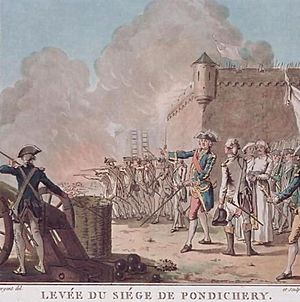Siege of Pondicherry (1748) facts for kids
Quick facts for kids The Siege of Pondichéry |
|||||||
|---|---|---|---|---|---|---|---|
| Part of The First Carnatic War | |||||||
 A later artistic representation of the end of the siege, by Antoine Louis François Sergent dit Sergent-Marceau |
|||||||
|
|||||||
| Belligerents | |||||||
| Commanders and leaders | |||||||
The Siege of Pondicherry was a major event that happened in India between August and October 1748. It was a fight between British forces and a French army stationed in the city of Pondicherry. This battle was part of a bigger conflict known as the First Carnatic War.
Contents
What Was the Siege of Pondicherry?
A siege is when an army surrounds a city or fort to try and take control of it. During the Siege of Pondicherry, the British army tried to capture the French-controlled port city. The French forces were led by Governor-General Joseph François Dupleix. The British attack was led by Admiral Edward Boscawen.
Why Did This Siege Happen?
The Siege of Pondicherry was part of the First Carnatic War. This war was fought in India between the British and French. It was also connected to a larger conflict happening in Europe called the War of the Austrian Succession. Both Britain and France wanted to control trade and land in India. This led to many battles between their armies and trading companies.
Who Were the Main People Involved?
- Joseph François Dupleix: He was the French Governor-General in India. He was in charge of the French forces defending Pondicherry. He was known for his strong leadership.
- Edward Boscawen: He was a British Admiral. He led the British forces trying to capture Pondicherry. His army had many soldiers and ships.
The Battle for Pondicherry
The British forces began their attack on Pondicherry in August 1748. They tried to use special methods called "siege tactics" to break through the city's defenses. However, Admiral Boscawen and his troops were not very experienced in these types of attacks.
How the Weather Changed the Battle
The siege continued for several months. But then, something unexpected happened: the monsoon rains arrived. Monsoons are very heavy seasonal rains that happen in India. The heavy rains made it very difficult for the British army to continue their attack. The ground became muddy, and it was hard to move cannons and supplies.
The End of the Siege
Because of the heavy monsoon rains, the British had to stop their attack. On October 27, 1748, they lifted the siege and left Pondicherry. This meant the French successfully defended their city. The Siege of Pondicherry was the last major battle of the First Carnatic War. Soon after, the war ended with a peace treaty.

